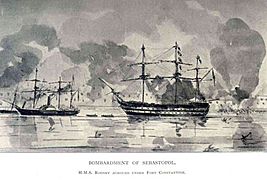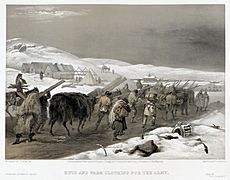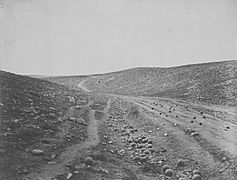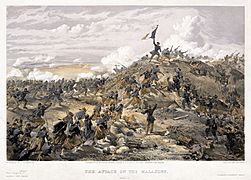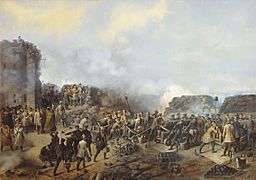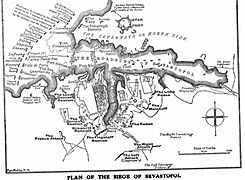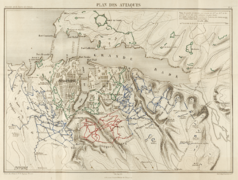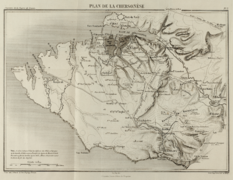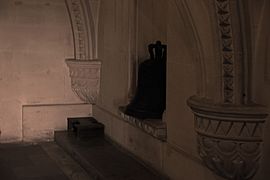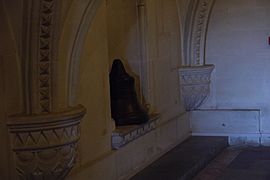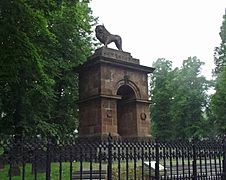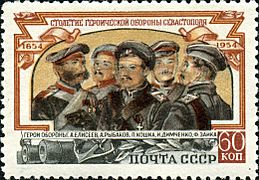Siege of Sevastopol (1854–1855) facts for kids
Quick facts for kids Siege of Sevastopol |
|||||||
|---|---|---|---|---|---|---|---|
| Part of the Crimean War | |||||||
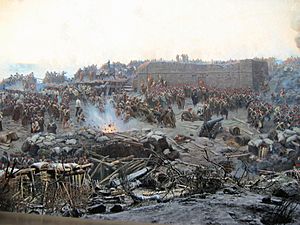 Siege of Sevastopol by Franz Roubaud (detail) |
|||||||
|
|||||||
| Belligerents | |||||||
| Commanders and leaders | |||||||
|
|
||||||
| Strength | |||||||
|
|
||||||
| Casualties and losses | |||||||
|
Total casualties: 102,000 killed, wounded, and died from disease | ||||||
The Siege of Sevastopol was a very long battle during the Crimean War. It lasted for almost a year, from October 1854 to September 1855. Sevastopol was a key city in the Crimea because it was home to the Russian Black Sea Fleet. This fleet was a threat to the Mediterranean.
The battle involved several countries working together, known as the Allies. These included soldiers from France, Sardinia, the Ottoman Empire, and Britain. They landed near Sevastopol in September 1854. Their goal was to capture the city.
Many important battles happened during the siege. These included Alma (September 1854), Balaklava (October 1854), and Inkerman (November 1854). The Allied navy also attacked the city six times with their ships.
The Siege of Sevastopol was one of the last "classic sieges" in history. This means it involved armies surrounding a city and trying to break through its defenses. The Russian army eventually pulled back, leaving the city to defend itself. The siege was the final major event of the Crimean War.
This battle was remembered in many ways. The famous Russian writer Leo Tolstoy wrote about it in his book Sebastopol Sketches. It was also the subject of Russia's first feature film, Defence of Sevastopol. A major street in Paris, the Boulevard de Sébastopol, was named after the victory. The "Charge of the Light Brigade" poem by Alfred, Lord Tennyson and the painting The Thin Red Line also came from battles during this time.
Contents
The Siege Begins: September 1854
The Allied forces, made up of French, Ottoman, and British soldiers, landed at Eupatoria on September 14, 1854. Soon after, they fought the Battle of the Alma on September 20. This is often seen as the first big battle of the Crimean War (1853–1856). The Allied forces, led by Jacques Leroy de Saint Arnaud and FitzRoy Somerset, 1st Baron Raglan, defeated the Russian army.
After this battle, the Allies moved to Balaklava. In early October, French and British engineers started building "siege lines." These were long trenches, forts (called redoubts), and gun batteries. They were built on the hills south of Sevastopol to surround the city.
The Russian army commander, Prince Menshikov, left the city. So, Vice Admirals Vladimir Alexeyevich Kornilov and Pavel Nakhimov took charge of Sevastopol's defense. They had help from Lieutenant Colonel Eduard Totleben, an engineer. The city's defenders included about 35,000 soldiers, sailors, and workers.
The city's naval defense had eight artillery batteries. Some were on the north shore, like Fort Constantine. Others were on the south shore, like Fort Pavel. To protect the harbor, the Russians also sank some of their own ships. They then used the cannons from these ships as extra artillery on land. The sailors from the ships became marines to help defend the city.
First Attacks: October 1854
By mid-October, the Allies had about 120 cannons ready to attack Sevastopol. The Russians had many more, about three times as many.
On October 17, the artillery battle began. Russian cannons first destroyed a French ammunition storage area, silencing their guns. Then, British fire hit a Russian ammunition storage in the Malakoff redoubt. This explosion killed Admiral Kornilov and silenced many Russian guns there. This left a weak spot in the city's defenses. However, the British and French did not launch a planned attack with their soldiers. This meant they missed a chance to end the siege early.
At the same time, the Allied navy attacked the Russian defenses from the sea. Many warships, both sail and steam-powered, were involved. After more than six hours of bombing, the Allied fleet did little damage to the Russian defenses. However, the Allied ships suffered many hits and had 340 casualties. Two British warships were so badly damaged they had to be towed away for repairs. The bombing continued the next day, but the Russians had worked all night to fix their defenses. This pattern of attack and repair happened many times during the siege.
Winter Challenges: November 1854
In late October and early November, two more big battles happened outside the siege lines: Balaclava and Inkerman. The Battle of Balaclava gave the Russians hope. They thought the Allied lines were weak and spread out. But after their defeat at Inkerman, the Russians realized they couldn't lift the siege by fighting outside the city. So, they sent more troops into Sevastopol to help defend it.
Toward the end of November, a terrible winter storm hit. It destroyed the Allies' camps and made it very hard to get supplies. Soldiers and horses became sick and starved because of the harsh conditions.
During this time, the Russian engineer Eduard Totleben made the fortifications stronger, especially around the Redan and Malakoff forts. The British chief engineer, John Fox Burgoyne, believed taking the Malakoff was key to winning the siege. The Allies started digging trenches closer to the Malakoff. In response, Totleben dug "rifle pits" where Russian soldiers could hide and shoot at the attackers. These trenches became very important, much like the trench warfare seen later in World War I.
The Final Push: 1855
When winter ended, the Allies were able to get supplies more easily. A new railway, the Grand Crimean Central Railway, was finished in March 1855. This railway brought supplies from Balaklava to the siege lines. It was 24 miles long and delivered over 500 cannons and lots of ammunition.
The Allies started bombing the fortress again on April 8. On July 10, Admiral Nakhimov, a key Russian commander, died from a head wound caused by an Allied sniper.
On September 5, the Allies began their sixth and strongest bombing attack. Over 300 cannons fired 150,000 rounds. The Russians suffered 2,000 to 3,000 casualties every day. On September 8, about 60,000 Allied soldiers launched the final attack. The British attack on the Great Redan failed. However, the French, led by General MacMahon, managed to capture the Malakoff redoubt and the Little Redan. This made it impossible for the Russians to defend the city.
By the morning of September 9, the Russian forces had left the southern part of Sevastopol. Even though the Russians fought bravely and the Allies suffered heavy losses, the fall of Sevastopol led to Russia's defeat in the Crimean War. Many Russian soldiers were buried in the Brotherhood cemetery. The main commanders who died, Nakhimov, Kornilov, and Istomin, were buried in a special Admirals' Burial Vault.
Key Battles During the Siege
- First Bombardment of Sevastopol (October 17, 1854)
- Battle of Balaclava (October 25, 1854)
- Battle of Little Inkerman (October 26, 1854)
- Battle of Inkerman (November 5, 1854)
- Russian attack at Balaklava stopped (January 10, 1855)
- Battle of Eupatoria (February 17, 1855)
- Allied attack at Chernaya stopped (February 20, 1855)
- Russian army captures the Mamelon (February 22, 1855)
- French attack on the "White Works" pushed back (February 24, 1855)
- Second Bombardment of Sevastopol (April 9, 1855)
- British successfully attack "the Rifle Pits" (April 19, 1855)
- Battle of the Quarantine Cemetery (May 1, 1855)
- Third Bombardment of Sevastopol (June 6, 1855)
- Allies successfully attack the "White Works," Mamelon, and "The Quarries" (June 8-9, 1855)
- Fourth Bombardment of Sevastopol (June 17, 1855)
- Allied attacks on the Malakoff and Great Redan pushed back (June 18, 1855)
- Battle of the Chernaya (August 16, 1855)
- Fifth Bombardment of Sevastopol (August 17, 1855)
- Sixth Bombardment of Sevastopol (September 7, 1855)
- Allies attack the Malakoff, Little Redan, Bastion du Mat, and the Great Redan (September 8, 1855)
- Russians retreat from Sevastopol (September 9, 1855)
Sevastopol Cannons and Trophies
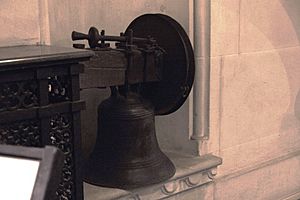
After the siege, the British took many cannons from Sevastopol as trophies. They sent these cannons to many towns in Britain and other important cities across the British Empire. Some were sent to military colleges like the Royal Military College, Sandhurst. Many of these cannons were later melted down during the Second World War to help with the war effort. Some have since been replaced with copies.
There's a story that the Victoria Cross, Britain's highest award for bravery, was made from the metal of cannons captured at Sevastopol. However, the company that makes the medals says the metal is actually Chinese bronze, not Russian. It seems the cannons used for the Victoria Cross were likely trophies from a war in China in the 1840s.
Parts of the Crimean War Memorial in London were made from melted-down Sevastopol cannons.
The Sevastopol Bells
At the end of the siege, British forces took two large bells from the Church of the Twelve Apostles as war trophies. Along with two smaller bells, they were brought to England. The largest bell was first displayed at the Royal Arsenal. Later, it was moved to Aldershot Garrison and then to the Cambridge Military Hospital. Today, it is at St Omer Barracks and is a protected historical structure.
The second large bell was taken to Windsor Castle. It was placed in the Round Tower. By tradition, this bell is only rung when a king or queen dies.
Images for kids
-
Bombardment of Sevastopol by HMS Rodney, Crimean War (October 1854)
-
A view of the "Valley of the Shadow of Death" near Sevastopol, taken by Roger Fenton in March 1855. It was so named by soldiers because of the number of cannonballs that landed there, falling short of their target, during the siege.
-
Map of the French (blue) and British (red) lines during the siege. The defenders' positions are in green.
-
Three 17th Century Russian Orthodox Church Bells in Arundel Castle, West Sussex United Kingdom. These bells were taken as trophies from Sevastopol at the conclusion of the siege of Sevastopol.
-
Three 17th Century Russian Orthodox Church Bells in Arundel Castle
-
Three 17th Century Russian Orthodox Church Bells in Arundel Castle
-
The Sevastopol Monument in Halifax, Nova Scotia is the only Crimean War monument in North America.
See also
- Sevastopol Sketches, a cycle of three historical fiction short stories written by Leo Tolstoy
- Defence of Sevastopol, Russia's first feature film



